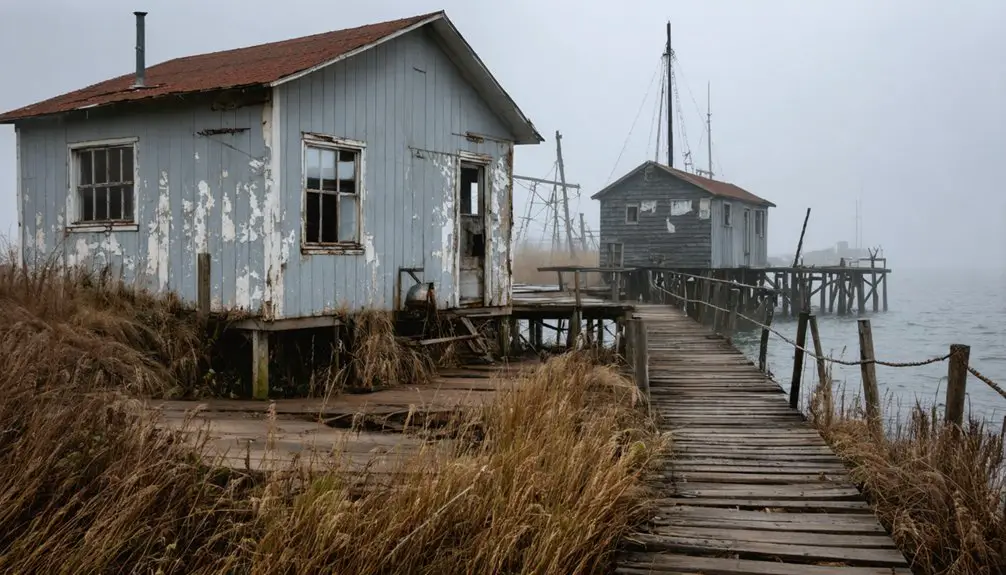You’ll find Sinipee’s remnants beneath Lock and Dam No. 11 on the Mississippi River, where this once-thriving port town flourished in the 1830s. The settlement boasted five steamship docks, twenty buildings, and prime lots selling for $2,000 during the lead trade boom. After a devastating flood in 1840 triggered disease outbreaks, residents fled, leaving only two families behind. The town’s dramatic rise and fall holds deeper secrets beneath today’s waters.
Key Takeaways
- Sinipee was established in the 1830s as a thriving Mississippi River port town known for lead trading and steamboat commerce.
- The town reached its peak in 1835 with 1,000 residents and property values up to $2,000 per lot.
- A devastating flood in 1840 triggered widespread disease, causing most residents to abandon the settlement.
- By 1859, only one building remained after the town’s collapse, with fires destroying most structures and residents relocating.
- Lock and Dam No. 11, built in 1934, submerged the original townsite, leaving minimal traces of Sinipee’s existence.
A Promising Port Along the Mississippi
While many frontier settlements struggled to gain a foothold along the Mississippi River in the 1830s, Port Sinipee emerged as a promising commercial hub at the confluence of Sinnipee Creek and the Mississippi in Grant County, Wisconsin.
You’d find this trade depot perfectly positioned across from Dubuque, where a dramatic flat-faced bluff served as a natural landmark for riverboat captains. The port’s strategic location made it ideal for river commerce, especially in the bustling lead trade that had flourished in the region for centuries. The Louisiana Company investors paid $12,000 to secure the prime riverfront property in 1838. The area’s rich deposits attracted many settlers, earning Wisconsin its enduring nickname as the Badger State.
Rise to Commercial Prominence
You’ll find Sinnipee’s rapid commercial ascent in 1835 was driven by its strategic position along the Mississippi River, where up to five steamships could dock simultaneously to transport lead ore.
The town’s lucrative lead trade attracted significant investment from Mineral Point financiers, with some town lots selling for as much as $2,000 during the initial real estate boom. The Louisiana Company formed to establish this promising river port.
Merchants, craftsmen, and traders flocked to establish businesses in Sinnipee’s growing port, which emerged as a crucial shipping hub competing with nearby Dubuque just four miles downriver.
Lucrative Lead Trade Era
During the late 1830s, Sinipee emerged as an essential commercial hub when the Louisiana Company, backed by Mineral Point investors, established a strategic port to capitalize on the region’s burgeoning lead trade.
You’d find up to five steamships docked simultaneously at the bustling port, transporting valuable lead ore downstream to broader markets, while merchants and craftsmen from Galena and Dubuque flocked to the town.
The economic boom transformed Sinipee into a crucial transshipment depot for lead mining operations throughout the Mineral District. Town lots sold for up to $2,000 as the population swelled to 1,000 residents. By 1844, the town experienced a dramatic decline as local miners departed for more promising opportunities elsewhere.
The construction of Vaughn’s hotel, featuring two-foot-thick stone walls and a grand ballroom, symbolized the town’s prosperity and commercial aspirations during this dynamic period. Like many settlements in Wisconsin’s southwest, Sinipee’s development was directly tied to the lead mining since 1820s, when European settlers first began extracting the valuable mineral.
Strategic Mississippi River Location
As the Louisiana Company sought to establish a strategic foothold along the Mississippi River in 1835, they selected Sinipee’s naturally advantageous location at the mouth of Sinipee Creek, just north of Dubuque, Iowa.
You’d find a towering limestone bluff and flowing spring that enhanced the site’s appeal for river navigation and commerce.
Under John Plumbe Jr.’s expert surveying, the town’s layout maximized its commercial potential with optimized riverfront access.
By 1839, you could spot up to five steamships simultaneously docked at the bustling port, while the settlement grew to include twenty buildings, including warehouses and the prominent Old Stone House hotel.
The port’s strategic position between St. Louis and northern territories made it an attractive hub for merchants, skilled workers, and regional investors.
Life in Early Sinnipee
While the early settlement of Sinnipee began with Payton Vaughan’s arrival before 1832, the town truly came to life in 1835 when the Sinnipee Company established it as a strategic port on the Mississippi River.
Early settlers transformed this wilderness into a bustling community, with architectural influences reflecting both practicality and sophistication. The area’s rich lead deposits attracted numerous fortune-seekers to the region.
- Carpenters, masons, merchants, and craftsmen built approximately twenty structures in just six months.
- The impressive Old Stone House hotel featured two-foot-thick walls and a grand ballroom.
- Pure spring water flowed beneath the hotel’s foundation at the bluff’s base.
- Lots sold for up to $2,000 during the town’s economic boom.
- The diverse population created a vibrant social scene centered around trade and community gatherings.
You’d have found a dynamic mix of commerce, construction, and cultural activities shaping daily life in early Sinnipee.
The Devastating Turn of Events
The prosperous trajectory of Sinnipee took a devastating turn in 1840 when a catastrophic flood ravaged the town’s infrastructure and triggered a chain of calamitous events.
In the flood aftermath, the damaged port facilities crippled crucial lead shipments, while the beloved Old Stone House hotel suffered extensive damage.
Worse still, the standing water sparked a severe fever outbreak that earned Sinnipee a reputation as a disease-ridden settlement. The disease impact proved catastrophic – all but two families fled, and property values plummeted as investors avoided the troubled town.
You’d have found Sinnipee eerily quiet by early 1840, its buildings standing empty like sentinels in a ghost town.
A later fire destroyed much of what remained, and by 1859, only one building still stood in the business district.
A Swift and Silent Exodus

You’d have found Sinipee’s transformation from a bustling port town of 1,000 residents to a near-empty shell startling, as fever and flooding drove most inhabitants away by 1840.
The mass departure happened so quickly that buildings stood pristine but vacant, while businesses, fortunes, and dreams crumbled in the wake of the exodus.
Within months, you’d have seen only two families remaining in what had become a genuine ghost town, its streets silent except for the distant sounds of the Mississippi River that had once brought such promise to this frontier settlement.
Disease Drives Mass Departure
Life in Sinipee changed drastically when a devastating malaria outbreak swept through the frontier settlement in 1840, driving nearly all residents to flee within months.
The disease impact devastated the once-promising town, with mosquito-borne “ague” breeding in stagnant flood waters. You’ll find that this rapid community collapse left only the Vaughn family behind as others abandoned their properties and livelihoods.
- Fever outbreaks made living conditions unbearable, leading to mass exodus
- Local businesses and river commerce came to an abrupt halt
- The hotel, a vital economic asset, closed and was later dismantled
- Disease fears stigmatized the area, preventing new settlement
- By 1859, only one building remained in the business district
The town’s swift abandonment created a haunting atmosphere that Theodore Rodolf described as resembling a “church-yard” – silent, empty, yet eerily preserved.
Abandoned Dreams and Fortunes
Beyond the devastating health crisis, Sinipee’s downfall represented shattered economic dreams of remarkable scale. You would’ve seen evidence of this in the abandoned $2,000 lots and 25 empty commercial buildings that once symbolized the town’s economic resilience.
The swift exodus left behind well-painted structures and a newly constructed hotel, indication of the community spirit that had driven initial prosperity.
The town’s demise was particularly striking given its early promise – with up to five steamships regularly moored at its port and a bustling lead trade operation.
Even the “wildcat” currency continued circulating after the population fled, a haunting reminder of unfulfilled ambitions. By 1840, only the Vaughan family remained where a thousand residents had once lived, leaving behind their investments and dreams of riverfront fortune.
Ghost Town Within Months
While Sinipee’s early years showed remarkable promise, the town’s transformation into a ghost town occurred with startling speed in the late 1830s. Settlement patterns shifted dramatically as malaria outbreaks devastated the population, turning this bustling port into an abandoned shell within months. The fatal outbreak occurred during an era when many early Wisconsin settlements were being established by hopeful pioneers. Like many other settlements, changes in transportation routes contributed to its decline.
- Buildings stood intact but empty, giving the town an eerie “church-yard” stillness.
- You’d find only two families remaining by 1840, down from a thriving population.
- Property values plummeted from $2,000 per lot to virtually worthless.
- Public health concerns from mosquito-breeding snowmelt sealed the town’s fate.
- Even the freshly constructed buildings couldn’t attract new settlers due to disease stigma.
The exodus was so complete that returning investors discovered a perfectly preserved yet completely deserted town, its commercial potential forever lost to the devastating impact of malaria.
Environmental Forces and Natural Challenges
Although Sinnipee initially showed promise as a bustling Mississippi River port town, devastating environmental forces ultimately sealed its fate.
The settlement’s location at the base of a bluff and mouth of Sinnipee Creek left it vulnerable to nature’s fury. You’ll find that flood management became impossible after the 1839 disaster, when melting snow and spring rains submerged the area, creating stagnant pools that bred mosquitoes.
Disease prevention proved equally challenging as malaria, then known as “ague,” spread rapidly through the population. The environmental assault continued as geological instability and recurring floods crippled the lead trade, while the ravine’s susceptibility to water fluctuations undermined infrastructure.
What Lies Beneath the Waters Today
The waters of Lock and Dam No. 11, constructed in 1934, now cover what remains of Sinipee’s original village site.
You’ll find a complex underwater landscape where this once-thriving village stood, though underwater exploration reveals few visible structures remain. The flooding permanently transformed the area into what’s now the Fenley Recreation Area, popular among anglers who fish these altered waters.
- Most wooden buildings were dismantled or relocated before the flooding
- The historic Stone Hotel, damaged by fire in 1904, was dismantled for dam materials
- Sediment layers have accumulated over potential submerged artifacts
- River pooling has created new aquatic habitats at the former town site
- Complex underwater topography exists where bluffs and creek mouths meet the river
Frequently Asked Questions
What Happened to the Residents Who Fled During the Fever Outbreak?
You’ll find those fleeing families scattered across neighboring towns after the fever aftermath, seeking safer settlements with medical care, though many faced ongoing health struggles and diminished opportunities.
Were There Any Indigenous Settlements in the Sinnipee Area Before 1835?
You might think this land was empty, but the Mesquakie and Sauk indigenous tribes actively mined lead and utilized the area, though there’s no evidence of permanent settlements directly at Sinipee before 1835.
How Did the Town’s Currency Maintain Value After Its Abandonment?
You’ll find that regional economic resilience and currency stability persisted through remaining trade networks, lingering local trust, and the necessity for monetary exchange in frontier areas lacking alternatives.
What Artifacts Have Been Recovered From Underwater Archaeological Explorations?
Like treasures in a dragon’s lair, you’ll find charred timbers and metal fittings from the L.W. Crane’s hull, wooden fragments bearing underwater discoveries of historical significance, and remnants of steamer machinery beneath Fox River.
Did Any Descendants of Original Sinnipee Settlers Remain in Grant County?
You’ll find limited descendant research and genealogical records to confirm who stayed, though some Vaughn family members were among the last known settlers to remain in Grant County’s communities.
References
- https://portalwisconsin.wordpress.com/2012/02/07/the-ghosts-of-sinipee/
- https://en.wikipedia.org/wiki/Sinnipee
- https://stephenjessetaylor.wordpress.com/2013/07/27/sinipee-of-the-driftless/
- https://www.oocities.org/old_lead/sinipee.htm
- https://www.ghosttowns.com/states/wi/sinipee.html
- https://stephenjessetaylor.wordpress.com/tag/ghost-towns/
- https://kids.kiddle.co/Sinnipee
- https://grow.cals.wisc.edu/deprecated/on-henry-mall/a-mining-history-charted-in-soil
- https://www.wisconsinhistory.org/Records/Article/CS408
- https://pbswisconsin.org/news-item/southern-wisconsins-ghost-towns-leave-behind-vital-stories/



